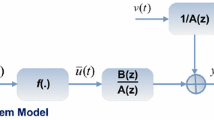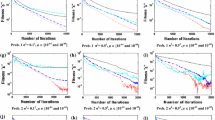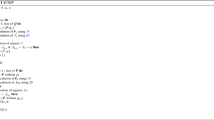Abstract
In the present study, strength of fractional-order adaptive signal processing through fractional Volterra least mean square (FV-LMS) algorithm is exploited for Hammerstein nonlinear control autoregressive model (HN-CAR) identification. The FV-LMS method is a generalization of standard V-LMS by taking usual gradient as well as fractional derivative of cost function in the optimization process. The adaptive scheme FV-LMS is applied to HN-CAR systems for different variations of step size parameter, noise and fractional order. Comparative study of the optimized design variables by FV-LMS from true values of HN-CAR model is carried out using performance metrics of fitness and mean square error, to establish its effectiveness. The performance of the proposed scheme is validated through comparison with standard V-LMS based on multiple independent runs of the scheme.







Similar content being viewed by others
References
Wang Y, Ding F (2016) Parameter estimation algorithms for Hammerstein–Wiener systems with autoregressive moving average noise. J Comput Nonlinear Dyn 11(3):031012
Banerjee A, Abu-Mahfouz I (2014) A comparative analysis of particle swarm optimization and differential evolution algorithms for parameter estimation in nonlinear dynamic systems. Chaos, Solitons Fractals 58:65–83
Strebel O (2013) A preprocessing method for parameter estimation in ordinary differential equations. Chaos, Solitons Fractals 57:93–104
Wang Y, Ding F (2016) Recursive least squares algorithm and gradient algorithm for Hammerstein–Wiener systems using the data filtering. Nonlinear Dyn 84(2):1045–1053
Wang D (2016) Hierarchical parameter estimation for a class of MIMO Hammerstein systems based on the reframed models. Appl Math Lett 57:13–19
Khani F, Haeri M (2015) Robust model predictive control of nonlinear processes represented by Wiener or Hammerstein models. Chem Eng Sci 129:223–231
Holcomb CM, de Callafon RA, Bitmead RR (2014) Closed-loop identification of Hammerstein systems with application to gas turbines. IFAC Proc 47(3):493–498
Togun N, Baysec S, Kara T (2012) Nonlinear modeling and identification of a spark ignition engine torque. Mech Syst Signal Process 26:294–304
Zhao Y, Jiang Y, Feng J, Wu L (2016) Modeling of memristor-based chaotic systems using nonlinear Wiener adaptive filters based on backslash operator. Chaos Solitons Fractals 87:12–16
Rébillat M, Hennequin R, Corteel E, Katz BF (2011) Identification of cascade of Hammerstein models for the description of nonlinearities in vibrating devices. J Sound Vib 330(5):1018–1038
Ugalde HMR, Carmona JC, Alvarado VM, Reyes-Reyes J (2013) Neural network design and model reduction approach for black box nonlinear system identification with reduced number of parameters. Neurocomputing 101:170–180
Oprisan SA (2002) An application of the least-squares method to system parameters extraction from experimental data. Chaos Interdiscip J Nonlinear Sci 12(1):27–32
Ugalde HMR, Carmona JC, Reyes-Reyes J, Alvarado VM, Mantilla J (2015) Computational cost improvement of neural network models in black box nonlinear system identification. Neurocomputing 166:96–108
Corbier C, Ugalde HMR (2016) Low-order control-oriented modeling of piezoelectric actuator using Huberian function with low threshold: pseudolinear and neural network models. Nonlinear Dyn 85(2):923–940
Vörös J (2015) Iterative identification of nonlinear dynamic systems with output backlash using three-block cascade models. Nonlinear Dyn 79(3):2187–2195
Guo Y, Guo LZ, Billings SA, Lang ZQ (2016) A new efficient system identification method for nonlinear multiple degree-of-freedom structural dynamic systems. J Comput Nonlinear Dyn 11(2):021012
Billings SA (2013) Nonlinear system identification: NARMAX methods in the time, frequency, and spatio-temporal domains. Wiley, Chichester
Chaudhary NI, Raja MAZ (2015) Design of fractional adaptive strategy for input nonlinear Box–Jenkins systems. Signal Process 116:141–151
Chen H, Xiao Y, Ding F (2014) Hierarchical gradient parameter estimation algorithm for Hammerstein nonlinear systems using the key term separation principle. Appl Math Comput 247:1202–1210
Mao Y, Ding F (2015) Multi-innovation stochastic gradient identification for Hammerstein controlled autoregressive autoregressive systems based on the filtering technique. Nonlinear Dyn 79(3):1745–1755
Mao Y, Ding F (2015) A novel data filtering based multi-innovation stochastic gradient algorithm for Hammerstein nonlinear systems. Digit Signal Process 46:215–225
Chaudhary NI, Zubair S, Raja MAZ (2016) Design of momentum LMS adaptive strategy for parameter estimation of Hammerstein controlled autoregressive systems. Neural Comput Appl. https://doi.org/10.1007/s00521-016-2762-1
Mao Y, Ding F (2016) A novel parameter separation based identification algorithm for Hammerstein systems. Appl Math Lett 60:21–27
Chaudhary NI, Raja MAZ (2015) Identification of Hammerstein nonlinear ARMAX systems using nonlinear adaptive algorithms. Nonlinear Dyn 79(2):1385–1397
Aslam MS, Chaudhary NI, Raja MAZ (2016) A sliding-window approximation-based fractional adaptive strategy for Hammerstein nonlinear ARMAX systems. Nonlinear Dyn. https://doi.org/10.1007/s11071-016-3058-9
Li G, Wen C, Zheng WX, Chen Y (2011) Identification of a class of nonlinear autoregressive models with exogenous inputs based on kernel machines. IEEE Trans Signal Process 59(5):2146–2159
Chen H, Ding F (2015) Hierarchical least squares identification for hammerstein nonlinear controlled autoregressive systems. Circuits Syst Signal Process 34(1):61–75
Chen H, Ding F, Xiao Y (2015) Decomposition-based least squares parameter estimation algorithm for input nonlinear systems using the key term separation technique. Nonlinear Dyn 79(3):2027–2035
Xiao Y, Song G, Liao Y, Ding R (2012) Multi-innovation stochastic gradient parameter estimation for input nonlinear controlled autoregressive models. Int J Control Autom Syst 10(3):639–643
Hu H, Ding R (2014) Least squares based iterative identification algorithms for input nonlinear controlled autoregressive systems based on the auxiliary model. Nonlinear Dyn 76(1):777–784
Raja MAZ, Shah AA, Mehmood A, Chaudhary NI, Aslam MS (2016) Bio-inspired computational heuristics for parameter estimation of nonlinear Hammerstein controlled autoregressive system. Neural Comput Appl. https://doi.org/10.1007/s00521-016-2677-x
Chaudhary NI, Raja MAZ, Khan JA, Aslam MS (2013) Identification of input nonlinearcontrol autoregressive systems using fractional signal processing approach. Sci World J 2013:467276
Chaudhary NI, Raja MAZ, Khan AUR (2015) Design of modified fractional adaptive strategies for Hammerstein nonlinear control autoregressive systems. Nonlinear Dyn 82(4):1811–1830
Podlubny I (1999) Fractional differential equations. Academic Press, New York
Kilbsa AA, Srivastava HM, Trujillo JJ (2006) Theory and applications of fractional differential equations, vol 204. Elsevier Science Limited, Amsterdam
Wu GC, Baleanu D, Xie HP (2016) Riesz Riemann–Liouville difference on discrete domains. Chaos Interdiscip J Nonlinear Sci 26(8):084308
Ortigueira MD (2011) Fractional calculus for scientists and engineers, vol 84. Springer, New York
Wu GC, Baleanu D (2014) Chaos synchronization of the discrete fractional logistic map. Signal Process 102:96–99
Srivastava HM, Baleanu D, Li C (2016) Preface: recent advances in fractional dynamics. Chaos Interdiscip J Nonlinear Sci 26(8):084101
Ortigueira MD, Machado JT (2006) Fractional calculus applications in signals and systems. Signal Process 86(10):2503–2504
Ortigueira MD, Ionescu CM, Machado JT, Trujillo JJ (2015) Fractional signal processing and applications. Signal Process 107:197
Alkahtani BST, Atangana A (2016) Analysis of non-homogeneous heat model with new trend of derivative with fractional order. Chaos Solitons Fractals 89:566–571
Wu GC, Baleanu D, Lin ZX (2016) Image encryption technique based on fractional chaotic time series. J Vib Control 22(8):2092–2099
Pu YF, Zhang N, Zhang Y, Zhou JL (2016) A texture image denoising approach based on fractional developmental mathematics. Pattern Anal Appl 19(2):427–445
Gómez-Aguilar JF (2017) Irving–Mullineux oscillator via fractional derivatives with Mittag-Leffler kernel. Chaos Solitons Fractals 95:179–186
Chen L, Pan W, Wu R, Wang K, He Y (2016) Generation and circuit implementation of fractional-order multi-scroll attractors. Chaos Solitons Fractals 85:22–31
Wu GC, Baleanu D, Xie HP, Zeng SD (2016) Discrete fractional diffusion equation of chaotic order. Int J Bifurc Chaos 26(01):1650013
Alkahtani BST (2016) Chua’s circuit model with Atangana–Baleanu derivative with fractional order. Chaos Solitons Fractals 89:547–551
Baleanu D, Güvenç ZB, Machado JT (eds) (2010) New trends in nanotechnology and fractional calculus applications. Springer, New York
Pu YF, Yi Z, Zhou JL (2016) Fractional hopfield neural networks: fractional dynamic associative recurrent neural networks. IEEE Trans Neural Netw Learn Syst. https://doi.org/10.1109/TNNLS.2016.2582512
Pu YF (2016) Analog circuit realization of arbitrary-order fractional hopfield neural networks: a novel application of fractor to defense against chip cloning attacks. IEEE Access. https://doi.org/10.1109/ACCESS.2016.2606160
Pu YF, Yi Z, Zhou J Li (2016) Defense against chip cloning attacks based on fractional hopfield neural networks. Int J Neural Syst. https://doi.org/10.1142/S0129065717500034
Malek H, Dadras S, Chen Y (2016) Fractional order esr modeling of electrolytic capacitor & fractional order failure prediction with application to predictive maintenance. IET Power Electron 9:1608–1613
Golmankhaneh AK, Arefi R, Baleanu D (2015) Synchronization in a nonidentical fractional order of a proposed modified system. J Vib Control 21(6):1154–1161
Safarinejadian B, Asad M, Sadeghi MS (2016) Simultaneous state estimation and parameter identification in linear fractional order systems using coloured measurement noise. Int J Control 89(11):2277–2296
Chen Y, Xue D, Visioli A (2016) Guest editorial for special issue on fractional order systems and controls. IEEE/CAA J Autom Sin 3(3):255–256
Baleanu D, Machado JAT, Luo AC (eds) (2011) Fractional dynamics and control. Springer, Berlin
Soorki MN, Tavazoei MS (2016) Constrained swarm stabilization of fractional order linear time invariant swarm systems. IEEE/CAA J Autom Sin 3(3):320–331
Zahoor RMA, Qureshi IM (2009) A modified least mean square algorithm using fractional derivative and its application to system identification. Eur J Sci Res 35(1):14–21
Chaudhary NI, Ahmed M, Khan ZA, Zubair S, Raja MAZ, Dedovic N (2018) Design of normalized fractional adaptive algorithms for parameter estimation of control autoregressive autoregressive systems. Appl Math Model 55:698–715
Pu YF, Zhou JL, Zhang Y, Zhang N, Huang G, Siarry P (2015) Fractional extreme value adaptive training method: fractional steepest descent approach. IEEE Trans Neural Netw Learn Syst 26(4):653–662
Chaudhary NI, Raja MAZ, Aslam MS, Ahmed N (2016) Novel generalization of Volterra LMS algorithm to fractional order with application to system identification. Neural Comput Appl. https://doi.org/10.1007/s00521-016-2548-5
Cheng S, Wei Y, Chen Y, Li Y, Wang Y (2016) An innovative fractional order LMS based on variable initial value and gradient order. Signal Process. https://doi.org/10.1016/j.sigpro.2016.11.026
Cheng S, Wei Y, Chen Y, Liang S, Wang Y (2016) A universal modified LMS algorithm with iteration order hybrid switching. ISA Trans. https://doi.org/10.1016/j.isatra.2016.11.019
Raja MAZ, Chaudhary NI (2015) Two-stage fractional least mean square identification algorithm for parameter estimation of CARMA systems. Signal Process 107:327–339
Raja MAZ, Chaudhary NI (2014) Adaptive strategies for parameter estimation of Box-Jenkins systems. IET Signal Process 8(9):968–980
Shah SM, Samar R, Khan NM, Raja MAZ (2016) Fractional-order adaptive signal processing strategies for active noise control systems. Nonlinear Dyn. https://doi.org/10.1007/s11071-016-2765-6
Geravanchizadeh M, Ghalami Osgouei S (2014) Speech enhancement by modified convex combination of fractional adaptive filtering. Iran J Electr Electron Eng 10(4):256–266
Zubair S, Chaudhary NI, Khan ZA, Wang W (2018) Momentum fractional LMS for power signal parameter estimation. Signal Process 142:441–449
Chaudhary NI, Zubair S, Raja MAZ (2017) A new computing approach for power signal modeling using fractional adaptive algorithms. ISA Trans 68:189–202
Schetzen M (1980) The Volterra and Wiener theories of nonlinear systems. Wiley, New York
Diniz PS (2013) Adaptive filtering algorithms and practical implementation, 4th edn. Springer, Boston, MA. ISBN 978-1-4614-4105-2
Sigrist Z, Grivel E, Alcoverro B (2012) Estimating second-order Volterra system parameters from noisy measurements based on an LMS variant or an errors-in-variables method. Signal Process 92(4):1010–1020
Azpicueta-Ruiz LA, Zeller M, Figueiras-Vidal AR, Kellermann W, Arenas-Garcia J (2013) Enhanced adaptive Volterra filtering by automatic attenuation of memory regions and its application to acoustic echo cancellation. IEEE Trans Signal Process 61(11):2745–2750
Tan L, Jiang J (2001) Adaptive Volterra filters for active control of nonlinear noise processes. IEEE Trans Signal Process 49(8):1667–1676
Haykin S (1966) Adaptive filter theory. Prentice Hall, Upper Saddle River
Xiong W, Fan W, Ding R (2012) Least-squares parameter estimation algorithm for a class of inputnonlinear systems. J Appl Math 2012:684074
Azad SK (2017) Enhanced hybrid metaheuristic algorithms for optimal sizing of steel truss structures with numerous discrete variables. Struct Multidiscip Optim 55(6):2159–2180
Azad SK (2018) Seeding the initial population with feasible solutions in metaheuristic optimization of steel trusses. Eng Optim 50(1):89–105
Azad SK, Akış T (2016) Automated selection of optimal material for pressurized multi-layer composite tubes based on an evolutionary approach. Neural Comput Appl. https://doi.org/10.1007/s00521-016-2563-6
Bildik N, Deniz S (2017) A new efficient method for solving delay differential equations and a comparison with other methods. Eur Phys J Plus 132(1):51
Deniz S, Bildik N (2017) A new analytical technique for solving Lane–Emden type equations arising in astrophysics. Bull Belg Math Soc-Simon Stevin 24(2):305–320
Author information
Authors and Affiliations
Corresponding author
Ethics declarations
Conflict of interest
All authors declared that there are no potential conflicts of interest.
Human and animal rights statements
All authors declared that there is no research involving human and/or animal.
Informed consent
All authors declared that there is no material that required informed consent.
Rights and permissions
About this article
Cite this article
Chaudhary, N.I., Manzar, M.A. & Raja, M.A.Z. Fractional Volterra LMS algorithm with application to Hammerstein control autoregressive model identification. Neural Comput & Applic 31, 5227–5240 (2019). https://doi.org/10.1007/s00521-018-3362-z
Received:
Accepted:
Published:
Issue Date:
DOI: https://doi.org/10.1007/s00521-018-3362-z




